|
Panasonic Toughbook 33
Panasonic's replacement of the venerable Toughbook CF-31 rugged notebook is a state-of-the-art fully detachable rugged 2-in-1 hybrid.
(by Conrad H. Blickenstorfer)
On February 27, 2017, Panasonic introduced in the UK the Toughbook 33, a 2-in-1 device that the company calls a fully rugged detachable laptop. On May 19, 2017, the CF33 was officially announced in the US as well.
It's the replacement of the venerable Panasonic Toughbook CF-31 that, against rising competition, had ruled the rugged laptop roost for a good many years. What you get here is, depending on how you look at it, a tablet that snaps onto an exceptionally well integrated keyboard, or a laptop where the display comes off and can be used as a tablet. This follows the example of the Toughbook CF-20 which in late 2015 replaced the almost equally venerable Toughbook CF-19 convertible notebook with a 2-in-1.
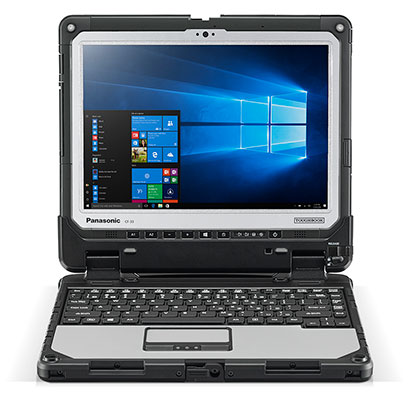
Replacing the Toughbook CF-31
Replacing the Toughbook CF-31 is the end of an era. It's been over two decades since Panasonic scored big with a toughened-up laptop, the CF-25, that would go on to become the Toughbook. The big yet remarkably elegant notebook with its pioneering magnesium case was an almost instant hit with all sorts of customers who needed something tougher than just a plasticky consumer clamshell.
Over time, the original Toughbook grew into a lineup of tough mobile computers and, since 2011, Toughpad tablets. As we now know, tablets didn't obliterate the PC market as pundits had predicted, but their impact was profound enough to bring upon the end of the original Toughbook. So from now on, the standard bearer Toughbook is different and can do a whole lot more:
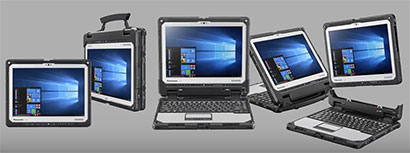
Panasonic's thought process is explained in a YouTube infographic video (see here). In it, Panasonic asks to imagine using a Toughbook CF-31, but you don't need the keyboard all the time. "Unfortunately," the video spokesman goes, "it's is attached and going nowhere, adding unnecessary weight, making it bulky, and reducing mobility." So there.
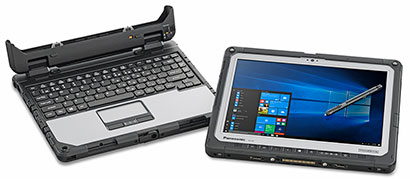
Ready for prime time?
The 2-in-1 concept isn't a new idea, as detachable keyboards have been available pretty much since the dawn of tablet computers in the early 1990s. But it took modern technology to make it feasible. That's because in a notebook the system board and most of the electronics are in the keyboard case, whereas in a tablet everything must be in the display part. In the past, this meant a thick, heavy tablet with a lightweight keyboard. Not exactly a recipe for stability. Today's tablets are much thinner and lighter. Which means that between clever design and a reasonably solid keyboard, a 2-in-1 combo is no longer nearly as top-heavy.
Now let's talk about size and weight. Since the Toughbook 33 replaces the Toughbook CF-31, how does the new 2-in-1 compare to its predecessor in size and weight? The CF-31 measured 11.9 x 11.5 inches, was 2.9 inches thick, and the last one we tested weighed a hefty 8.9 pounds. The new 33 has a footprint of 11.8 x 9.5 inches. It's not as tall because Panasonic switched from the squarish 4:3 aspect ratio in the CF-31 to a slightly wider 3:2. The 33 is an inch thinner and considerably lighter, though the extended snap-on batteries of the CF-33 will narrow that gap.

High tech
On the technology side, the Toughbook 33 looks quite impressive. While the final CF-31 maxed out with an Intel 5th generation "Broadwell" Core i5 processor, the new CF-33 skips right to a 7th generation "Kaby Lake" Core i5-7300 and Core i7-7600 chips. 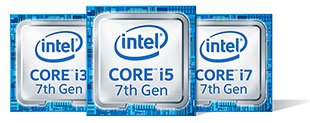 So that's two generations' worth of Intel advances, and likely a noticeable improvement in performance and efficiency. IF you run Windows 10 on it. Customers who want to take advantage of the Windows 7 "downgrade" must make do with 6th generation "Skylake" Core i5-6300 and Core i7-6600 chips, because Microsoft and Intel decided that Kaby Lake would not support anything prior to Windows 10. Any which way, the CF-33 should be a nimble machine indeed. So that's two generations' worth of Intel advances, and likely a noticeable improvement in performance and efficiency. IF you run Windows 10 on it. Customers who want to take advantage of the Windows 7 "downgrade" must make do with 6th generation "Skylake" Core i5-6300 and Core i7-6600 chips, because Microsoft and Intel decided that Kaby Lake would not support anything prior to Windows 10. Any which way, the CF-33 should be a nimble machine indeed.
The display measures 12 inches diagonal, down from the CF-31's 13.3 inches. However, with 2,160 x 1,440 resolution there are almost four times as many pixels than in the CF-31's 1,024 x 768 XGA screen. We're talking much, much sharper. The display uses anti-glare and anti-reflective treatments for best possible outdoor viewability, aided by a very bright 1,200 nits backlight.
There's 10-point capacitive multi-touch with glove/wet capability, with or without digitizer. The specs don't say what sort of pen it is, but does refer to a "waterproof IP55" (IP55 doesn't really mean waterproof, that'd be IP67) pen and a digitizer. This means it could be active pen technology (such as Wacom), or it could be the superb narrow-tip passive pen used in the Panasonic Toughpad M1 (though that does not technically use an extra digitizer).
There's optional 4G LTE and dedicated uBlox NEO M8N GPS (that's the kind that can concurrently use multiple positioning systems). Optional functionality includes a magstripe reader, an insertable SmartCard reader, a contactless SmartCard/NFC, a fingerprint reader, a true serial port, and additional USB ports. Note, though, that for most of those it means either this option or that option, but not all at once.
Separation of power
Nothing is ever totally simple, of course, and that also applies to converting a monolithic notebook into two separate components. In traditional notebooks, computing electronics and battery reside beneath the keyboard, but if if you move to a 2-in-1 system, the computer must be behind the display, and battery power as well.
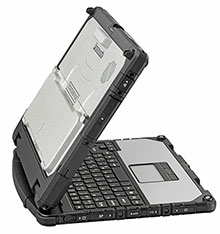
That makes the display part thicker and heavier (just what you don't want), and the keyboard part thinner and lighter (also just what you don't want). Now add to that at least a minimum of I/O ports when in tablet mode, and things get more difficult yet. How did Panasonic handle that?
Well, the tablet part weighs 3.4 pounds with standard batteries, and the keyboard part 2.7 pounds. That still makes the CF-33 top-heavy even with the standard batteries. The images we've seen so far aren't conclusive, but it looks like the extractable carry handle that's part of the keyboard might be used to make a larger footprint. That would give the 2-in-1 assembly more stability in laptop mode.
What about the necessary splitting of ports between tablet and base? Here Panasonic opted for giving the tablet a USB 3.0 port, an HDMI port, audio, an RJ45 LAN port, and an optional serial port. On the keyboard/base side are two more USB 3.0 ports, a USB 2.0 port, HDMI and VGA, and Ethernet. That seems a good balance, but for those who relied on the full complement of ports on the old CF-31, this might mean they'll have to take the keyboard part with anyway.
Sparse ruggedness specs
Panasonic calls the Toughbook 33 "fully-rugged" and, having visited Panasonic's ruggedness testing lab in Japan, we have every reason to believe that it is. Unfortunately, the only hard data supplied in the documentation is the IP65 rating, where the "6" stands for totally dustproof and the "5" that the device is protected against low-pressure jets of water from all directions. There's also mention of an optional Class 1 Division 2 Groups ABCD certified version for use in certain hazardous locations. And the CF-33 can handle 4-foot drops.
We feel that Panasonic ought to supply more detailed ruggedness information in their spec materials, especially since the Toughbook 33 starts at a rather hefty US$3,723. Since it's the very ruggedness of the product that justifies the price, many customers would likely be quite interested in how rugged, exactly, the new Toughbook CF-33 is.
Suitable successor for the CF-31?
Just when we thought traditional fully-rugged, full-size laptops would never change, Panasonic makes the next step. Paying homage to the tablet trend and trusting advanced technology to make the move from all-in-one laptop to detachable two-in-one hybrid work, Panasonic did it.
The state-of-the-art tech is formidable and certainly much appreciated, but is the design stable enough, the tablet light enough, the reduced battery life still long enough? And what about the backward compatibility that's now reduced (though an optional vehicle docking adapter makes the 33 fit into existing vehicle docks). Time will tell -- Conrad H. Blickenstorfer, February/May 2017
|



